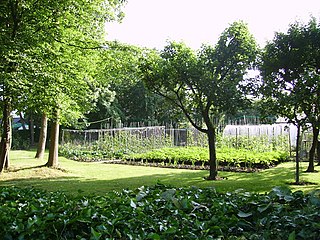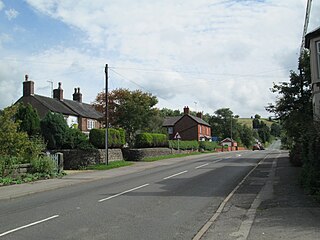
Basingwerk Abbey is a Grade I listed ruined abbey near Holywell, Flintshire, Wales. The abbey, which was founded in the 12th century, belonged to the Order of Cistercians. It maintained significant lands in the English county of Derbyshire. The abbey was abandoned and its assets sold following the Dissolution of the Monasteries in 1536.

Hugh of Cyfeiliog, 5th Earl of Chester, also written Hugh de Kevilioc, was an Anglo-Norman magnate who was active in England, Wales, Ireland and France during the reign of King Henry II of England.

Bordesley Abbey was a 12th-century Cistercian abbey near the town of Redditch, in Worcestershire, England.

Ranulf de Blondeville, 6th Earl of Chester and 1st Earl of Lincoln, known in some references as the 4th Earl of Chester, was one of the "old school" of Anglo-Norman barons whose loyalty to the Angevin dynasty was consistent but contingent on the receipt of lucrative favours. He has been described as "almost the last relic of the great feudal aristocracy of the Conquest".

The Brindley Water Mill is a water mill in the town of Leek, Staffordshire, England, built in 1752 by James Brindley. It was restored to working order in the 1970s, and is now a museum. It is a Scheduled Monument and a Grade II Listed Building.
The Abbey of St. Mary at Stanlaw, was a Cistercian foundation situated on Stanlaw - now Stanlow Point, on the banks of the River Mersey in the Wirral Peninsula, Cheshire, England, near Ellesmere Port, 11 km north of Chester Castle and 12 km south-west of Halton Castle.

Combermere Abbey is a former monastery, later a country house, near Burleydam, between Nantwich, Cheshire and Whitchurch in Shropshire, England, located within Cheshire and near the border with Shropshire. Initially Savigniac and later Cistercian, the abbey was founded in the 1130s by Hugh Malbank, Baron of Nantwich, and was also associated with Ranulf de Gernons, Earl of Chester. The abbey initially flourished, but by 1275 was sufficiently deeply in debt to be removed from the abbot's management. From that date until its dissolution in 1538, it was frequently in royal custody, and acquired a reputation for poor discipline and violent disputes with both lay people and other abbeys. It was the third largest monastic establishment in Cheshire, based on net income in 1535.

Dieulacres Abbey was a Cistercian monastery established by Ranulf, Earl of Chester at Poulton in Cheshire. It moved to the present site at Abbey Green near Leek, Staffordshire in 1214, possibly in part as a result from raids at the former site by Welsh marauders.
Ranulf le Meschin, 3rd Earl of Chester (1070–1129) was a Norman magnate based in northern and central England. Originating in Bessin in Normandy, Ranulf made his career in England thanks to his kinship with Hugh d'Avranches - the Earl of Chester, the patronage of kings William II Rufus and Henry I Beauclerc, and his marriage to Lucy, heiress of the Bolingbroke-Spalding estates in Lincolnshire.
Hawise of Chester, 1st Countess of Lincoln suo jure, was an Anglo-Norman noblewoman and a wealthy heiress. Her father was Hugh de Kevelioc, 5th Earl of Chester. She was the sister and a co-heiress of Ranulf de Blondeville, 6th Earl of Chester. She was created suo jure 1st Countess of Lincoln in 1232. She was the wife of Robert de Quincy, by whom she had one daughter, Margaret, who became heiress to her title and estates. She was also known as Hawise of Kevelioc.

Poulton is a settlement and former civil parish, now in the parish of Poulton and Pulford, in the Cheshire West and Chester, in the ceremonial county of Cheshire, England. In 2001 census the parish had a recorded population of 92.
The timeline of Cheshire history shows significant events in the history of the English county of Cheshire.
Hulton Abbey is a scheduled monument in the United Kingdom, a former monastery located in what is now Abbey Hulton, a suburb of Stoke-on-Trent. A daughter house of the Cistercian Combermere Abbey, the abbey was founded by Henry de Audley in the early 13th century. Throughout its life, the abbey was relatively small and poor, with one of the lowest incomes of all Staffordshire religious houses. The abbey was dissolved by Henry VIII in 1538, with its land and assets being sold.
Poulton Abbey was a Cistercian medieval monastic house in Poulton, Cheshire, England, which was founded between 1153 and 1158, and moved in 1214 to a site near Leek, Staffordshire, where it became Dieulacres Abbey. The original site became a grange estate of the abbey, and the chapel at the site was used as a one-room local church. In 1487 the abbey leased the estate to the prominent Manley family and the chapel was expanded to include a nave, chancel, and tower for use as its private chapel. By the 16th century all abbey buildings had been lost, though the site of the chapel was noted on a 17th-century estate map and later on the first Ordnance Survey map (1823).

Burleydam is a small English village in the civil parish of Dodcott cum Wilkesley in the unitary authority of Cheshire East and the ceremonial county of Cheshire, near the border with Shropshire. It is on the A525. The nearest town is Whitchurch in Shropshire, around 8 km (5 miles) to the west; nearby small settlements include Barnett Brook, Grindley Green and Royal's Green in Dodcott cum Wilkesley; Dodd's Green and Newhall in Newhall civil parish; and Old Woodhouses and New Woodhouses in Shropshire.

James Hall was an English antiquary, historian and schoolteacher, best known for his history of the Cheshire town of Nantwich, which remains among the principal sources for the town's history. He also edited accounts of the English Civil War and documents relating to Combermere Abbey. Another work on the history of Combermere Abbey, Newhall and Wrenbury was never published; its manuscript has been lost. Hall is commemorated in Nantwich in several ways, including a street named for him.

Rushton is a civil parish in Staffordshire, England. The village within the civil parish, usually known as Rushton Spencer, is about 4 miles (6.4 km) north of Leek and 7 miles (11 km) south of Macclesfield, on the A523 road which runs between these towns.

Leekfrith is a civil parish in the Staffordshire Moorlands, in Staffordshire, England, north of the town of Leek. The population of the civil parish at the 2011 census was 363.













